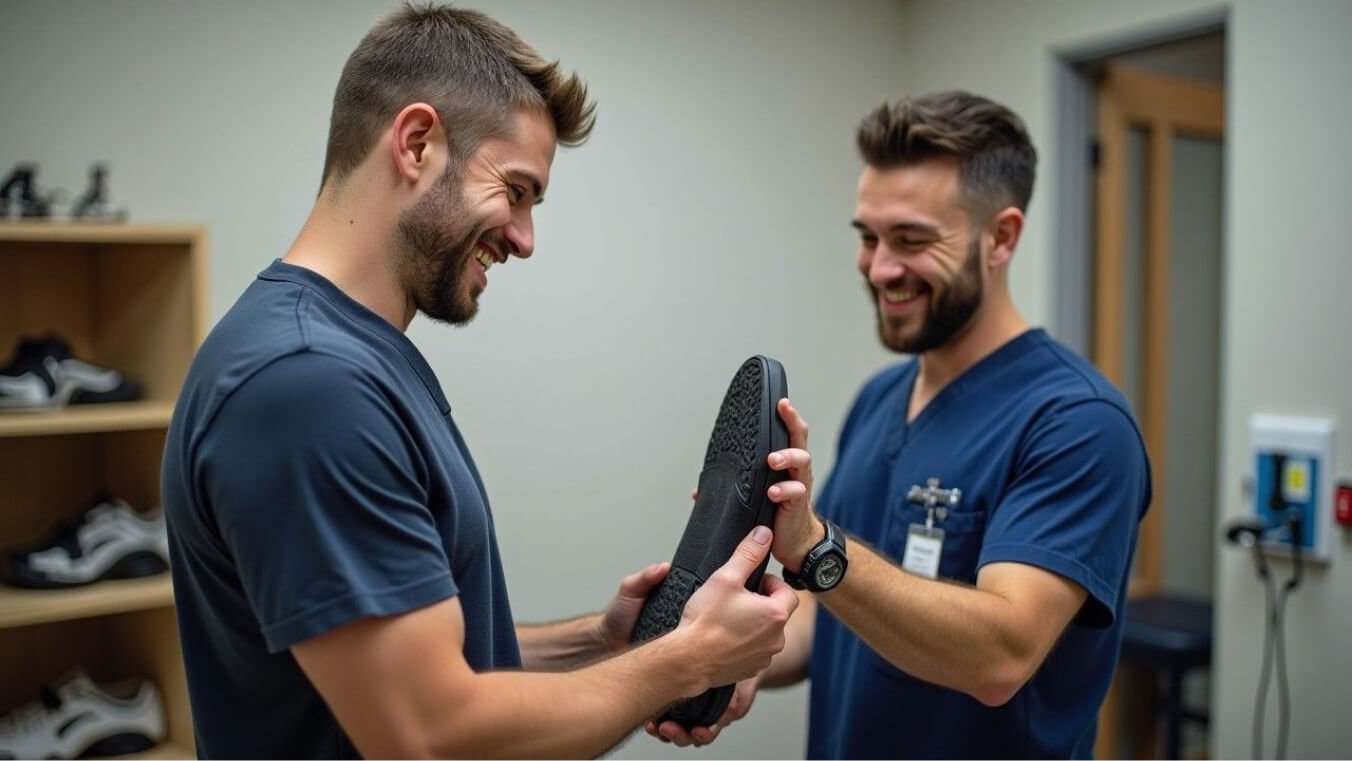DVA Podiatry: A Veteran’s Guide to Accessing Podiatry Services with Your Gold or White Card
DVA podiatry involves essential podiatry services funded by the Department of Veterans’ Affairs to support veterans’ foot health. These services include routine care, orthotics, and advanced treatments designed to improve mobility and comfort. Knowing how to access and use these benefits ensures veterans receive the care they need. Keep reading to learn more about eligibility, referrals, and maximising these services.
A Quick Guide to Podiatry Services Covered by the DVA
The Department of Veterans’ Affairs (DVA) funds podiatry services to help veterans maintain foot health and mobility, including routine care, custom orthotics, and advanced treatments tailored to individual clinical needs. Accessing these services requires a valid referral from a general practitioner (GP) and depends on eligibility. Gold Card holders receive full coverage, while White Card holders can access care for conditions accepted by the DVA as service-related.
Start Your DVA Claim Today
Get expert help to navigate the claim process and secure the compensation you deserve. With zero upfront fees, you only pay for successful claims.
What Podiatry Services Does the DVA Cover?
The DVA supports veterans by providing comprehensive podiatry services to maintain foot health and improve mobility. These services address a variety of conditions and needs, ensuring veterans receive tailored care.
Routine Consultations
DVA funds routine podiatry consultations to address common foot health concerns, including:
Assessments and diagnoses
Treatment for ingrown toenails, corns, and calluses
Management of foot pain and injuries
Basic foot hygiene and preventative care
Advanced Podiatry Treatments
For more serious conditions, the DVA provides access to advanced podiatry treatments that address complex foot health needs. These treatments are available when deemed clinically necessary and align with the veteran's approved treatment plan. Advanced services may include:
Nail surgeries to correct chronic issues or prevent further complications
Diagnostic services, such as gait analysis and muscle testing, when required to inform treatment plans
Physical therapies, including paraffin wax baths or electrophysical treatments, to manage foot pain and improve mobility
Footwear repairs and custom adjustments to ensure proper fit and functionality
Veterans should consult their podiatrist to confirm eligibility for these services and ensure all treatments meet DVA guidelines. Diagnostic services and therapies are only covered when they directly support an assessed clinical need.
Eligibility for Podiatry Services Covered by the DVA
Veterans can access podiatry services funded by the DVA if they meet specific eligibility criteria. Understanding these requirements ensures veterans receive appropriate care tailored to their needs.
Who Can Access Podiatry Services?
Eligibility is determined by the type of DVA card a veteran holds:
Gold Card Holders: Veterans with a Gold Card are eligible for all podiatry services covered by the DVA. However, treatments must address assessed clinical needs to qualify for funding.
White Card Holders: Veterans with a White Card are eligible for podiatry care related only to conditions accepted by the DVA as service-related. For instance, if a veteran’s White Card covers foot-related injuries, they can receive podiatry services specifically for those injuries. Pre-approval may be necessary for certain treatments or advanced care.
Requirements for Access
To begin podiatry care funded by the DVA, veterans must have:
A valid DVA referral from their general practitioner (GP).
Their DVA card for verification at appointments.
Documentation confirming the condition covered by the White Card, if applicable.
Are There Any Restrictions?
Certain treatments, such as custom orthotics, medical-grade footwear, or advanced procedures, may require prior approval from the DVA to ensure they align with assessed clinical needs and funding guidelines. Veterans should work closely with their podiatrist to determine if approval is needed, understand any potential out-of-pocket costs for upgrades or replacements beyond standard coverage, and submit required documentation in advance to avoid delays in care.
Confirming Eligibility
To avoid delays, veterans can confirm their eligibility by contacting their GP, podiatrist, or the DVA directly. Verifying these details helps ensure smooth access to the podiatry services they need.
The Role of a Referral in Accessing Podiatry Care
A DVA referral is essential for veterans to access podiatry services funded by the DVA. The referral ensures that treatments meet eligibility criteria and align with the veteran's health needs.
Why Is a Referral Required?
A referral serves as the starting point for receiving podiatry services. It ensures that veterans access the correct care for their conditions. Referrals also provide clarity to podiatrists, allowing them to deliver tailored treatments that meet DVA standards.
How to Obtain a Referral
Veterans must visit their general practitioner (GP) to request a referral. The GP will:
Assess the veteran's condition.
Confirm eligibility under the DVA scheme.
Provide a written referral specifying the required treatment.
Referrals must be valid and align with the treatment cycle guidelines. Each referral typically covers up to 12 sessions, whichever ends first.
What Does the Referral Include?
A standard referral includes:
The veteran’s DVA card details.
Information about the condition being treated.
The recommended podiatrist or clinic.
For White Card holders, the GP must confirm that the DVA accepts the treated condition.
Ensuring Smooth Access
Veterans should present their referral during their initial appointment with the podiatrist. This ensures treatments can begin without delays. Veterans needing advanced procedures or orthotics may also require prior approval from the DVA.
Keep Your Referral Up to Date
Referrals expire after completing the treatment cycle. Veterans should consult their GP to renew referrals and continue care.
Initial Consultation and Appointment Steps
An initial consultation is the first step for veterans accessing podiatry services through the DVA. It sets the foundation for care and ensures treatments align with the veteran’s health needs and eligibility.
Before the Appointment
Veterans should prepare for their first appointment by gathering essential documents and information:
DVA card: Bring your Gold or White Card to verify eligibility.
Referral: Provide a valid referral from your GP.
Medical history: Prepare details about your condition and any treatments you’ve received.
Having these ready helps avoid delays and ensures the podiatrist can start treatment promptly.
What Happens During the Initial Consultation?
The podiatrist will conduct a thorough assessment to understand your needs. This may include:
Discussing your medical history and current concerns.
Examining your foot health, including gait analysis or range-of-motion tests.
Developing a treatment plan tailored to your condition.
The initial consultation also includes completing or updating your care plan. This ensures ongoing treatments follow DVA guidelines.
Steps After the Appointment
After the consultation:
Follow the podiatrist’s recommendations for treatment or further tests.
Schedule follow-up appointments as needed.
Ensure your podiatrist submits an End of Cycle Report to your GP when required.
Tips for a Smooth Appointment
Arrive on time to your clinic with all required documents.
Communicate any issues or concerns during the session.
Ask about potential out-of-pocket costs for advanced treatments or orthotics.
Common Podiatry Services Covered by the DVA
The DVA funds various podiatry services to help veterans maintain their foot health. These services address various conditions, support mobility, and improve overall quality of life.
Routine Consultations
Veterans can access routine care to manage ongoing foot health issues. These consultations include:
Nail care and treatment for ingrown nails.
Corn and callus removal to prevent discomfort.
Management of foot pain caused by injuries or chronic conditions.
Routine visits also help prevent future complications through early detection and treatment.
Orthotic Devices and Footwear
Custom orthotic devices and medical-grade footwear are available to improve mobility and relieve pain. These items are tailored to each veteran’s needs and may include:
Custom insoles to correct foot alignment.
Orthotic devices for added support.
Specialised footwear for foot deformities or pressure relief.
Veterans need a prescription from their podiatrist for these items, which may require prior approval.
Diagnostic Services
DVA covers diagnostic assessments to identify the cause of foot problems. These services may include:
Gait analysis to evaluate walking patterns.
Muscle strength testing.
Range-of-motion studies.
These assessments guide the development of a personalised treatment plan.
Surgical Podiatry
For more serious conditions, veterans can access surgical services, such as:
Nail surgeries to remove damaged or ingrown nails.
Procedures to address bunions or other structural issues.
Therapeutic Services
DVA also provides funding for therapies, including:
Paraffin wax baths for foot pain relief.
Electrophysical therapies like ultrasound or TENS.
Navigating Treatment Cycles for Continued Care
The treatment cycle framework helps veterans access ongoing podiatry care while ensuring all services align with DVA guidelines. Understanding this process ensures care remains uninterrupted and meets clinical needs.
What Is a Treatment Cycle?
A treatment cycle provides a structured approach to accessing allied health services, including podiatry. It allows veterans to receive up to 12 sessions of care or continue until the treatment goals are achieved, whichever comes first. The podiatrist will monitor progress throughout the cycle and determine when it should end based on clinical outcomes.
How Does It Work?
Referral: Veterans must start with a valid DVA referral from a GP. The referral outlines the care required and specifies the podiatrist providing the services.
Initial Appointment: During the first session, the podiatrist conducts an assessment and develops a treatment plan tailored to the veteran’s condition.
Ongoing Care: Veterans receive podiatry care based on the treatment plan. Services may include routine care, orthotic fittings, and advanced treatments like diagnostic assessments or surgery.
What Happens at the End of a Cycle?
The treatment cycle concludes once the podiatrist determines that the treatment goals have been met or the maximum of 12 sessions has been reached. At the end of the cycle, the podiatrist submits an End of Cycle Report to the referring GP. This report includes a summary of care provided and recommendations for further treatment if needed.
Starting a New Cycle
If more care is required, the GP can issue a new referral based on the podiatrist’s recommendations. This ensures that treatment continues without delays or interruptions.
Addressing Common Issues in Accessing podiatry Services
Accessing podiatry services through the DVA can sometimes involve challenges. Understanding these common issues and how to address them ensures smooth and timely care for veterans.
Incomplete or Invalid Referrals
A valid DVA referral is required to start a treatment cycle. Issues often arise when referrals are incomplete or do not match DVA guidelines. To avoid delays:
Ensure the referral includes the veteran’s DVA card details, the condition being treated, and the recommended podiatrist.
Confirm that referrals for White Card holders specify accepted conditions.
If the referral is missing information, consult your GP to update it before your appointment.
Delays in Approval for Advanced Services
Some podiatry treatments, like orthotics or surgery, require prior approval from the DVA. Waiting for this approval can delay care. To address this:
Submit all required documents, including a detailed treatment plan, promptly.
Work with your podiatrist to ensure accurate and complete submissions.
Unclear Coverage for Specific Conditions
Veterans with a White Card may face confusion about which conditions are covered. To avoid this:
Check your card holder status and accepted conditions with the DVA or your GP.
Clarify any concerns before starting treatment to prevent unexpected out-of-pocket costs.
Miscommunication with Providers
Miscommunication between veterans, podiatrists, and GPs can lead to issues with ongoing care. To address this:
Communicate openly about your foot health concerns during appointments.
Ensure your podiatrist provides timely End of Cycle Reports to your GP.
Tips for Seamless Access
Keep your DVA card and medical history ready for each visit.
Consult trusted providers familiar with DVA requirements.
Follow up on referrals or approval requests to avoid unnecessary delays.
Maximising Your Podiatry Benefits Through the DVA
Your DVA card determines your access to podiatry services. Understanding the difference between Gold Card and White Card benefits is key:
Gold Card Holders: Access all podiatry services for any condition.
White Card Holders: Access podiatry care only for accepted conditions. Check your card status with the DVA or your GP to avoid confusion.
Use Referrals Wisely
Start each treatment cycle with a valid DVA referral from your GP. The referral ensures your treatment plan aligns with DVA guidelines. Work with your GP to:
Identify the right podiatrist.
Include all relevant details about your condition.
Renew referrals promptly at the end of each cycle to continue care without delays.
Work With Trusted Providers
Choose podiatrists experienced in providing podiatry services to veterans. Trusted providers:
Understand DVA requirements.
Help navigate approval processes for treatments like orthotics or surgery.
Track Your Sessions and Reports
Each treatment cycle includes up to 12 sessions. Keep track of your appointments and ensure your podiatrist submits the End of Cycle Report to your GP. This ensures continuity of care and allows you to start a new cycle if needed.
Stay Proactive
Veterans can maximise their benefits by staying informed and proactive. Communicate openly with your podiatrist about concerns. Follow up on referrals, approvals, and reports.
FAQs About Podiatry Services
-
Yes, some services, like custom orthotics or medical grade footwear, may require prior approval from the DVA. Your podiatrist will guide you through this process and help ensure all requirements are met.
-
For additional information, consult an expert in podiatry or email the DVA at their support centre. They can guide you through the process and help you access approved services to the DVA.
-
Most DVA-funded podiatry services are bulk billed, so veterans typically do not incur out-of-pocket costs for eligible treatments. However, some situations may involve additional fees, such as:
Upgrades to custom orthotics or medical-grade footwear that go beyond standard DVA coverage.
Replacement items exceeding DVA limits, like extra pairs of insoles or orthotics.
Non-standard treatments or modifications not included in DVA’s approved funding guidelines.
-
An orthosis is a custom device designed to support or correct foot function and alleviate discomfort. The DVA funds orthotics for eligible veterans when prescribed by a podiatrist as part of an approved treatment plan. Coverage is subject to DVA guidelines, including frequency limits and clinical necessity. Veterans should confirm their eligibility with their podiatrist to ensure the orthosis aligns with their treatment plan and DVA requirements.
Final Thoughts on Podiatry Services
Podiatry care supports veterans' mobility and overall health, with the DVA providing comprehensive coverage for eligible treatments, orthotics, and diagnostic services. Understanding eligibility, using referrals effectively, and working with trusted providers ensures veterans maximise these benefits. Staying proactive, communicating with healthcare teams, and tracking treatment cycles helps veterans access the care they need to remain active and healthy.
Simplify Your DVA Claim: Get the Compensation You Deserve
Veterans First Consulting is here to guide you. Leave us a message, and a team member will reach out to discuss your new claim or reassessment. With zero upfront fees, you only pay for successful claims. Fill out the form below to get started.




